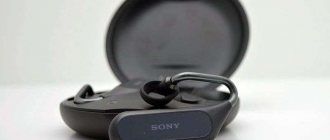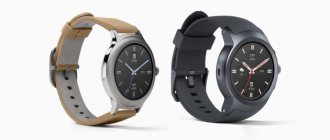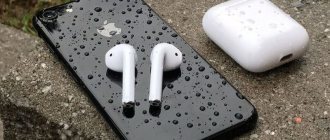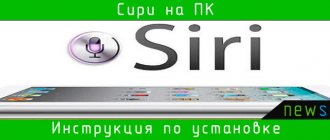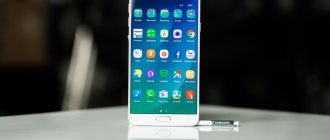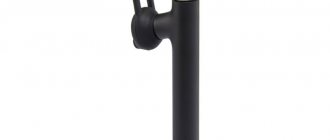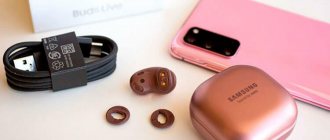Today we will look at another, more advanced and interesting wireless headphones from Jabra – Sport Pulse. They feature an excellent fitness tracker with heart rate monitoring, high-quality headphones and a convenient headset for communication.
The accessory received Apple certification with the corresponding designation “Made for iPod, iPhone, iPad” and an honorary award in the field of innovation at CES 2020.
Design and equipment
Jabra Pulse has a stylish and modern design, the headphones are connected by a 58 mm cable with a built-in remote control. You can use them anywhere without worry: the product meets the US military standard for resistance to rain, sand, dust and shock (IP55).
A set of two types of interchangeable tips allows you to securely fix the headphones and choose the optimal size for you. The choice of possible combinations is quite large, the materials are of high quality and pleasant to the tactile sensations.
The MicroUSB connector is located under the latch on the right earphone. In order to access it, you need to slightly lift or move the nozzle.
Jabra Pulse is easy to use both during leisure and during sports. No matter how hard you try, if the headphones are held in place well, they will not fall out. The weight of the device is only 16 g, the accessory does not distract or create discomfort. When you first experience with in-ear headphones, there is a slightly unusual feeling, but it quickly passes.
The set includes a convenient case for storing and transporting headphones and removable tips.
The accessory is packaged in a beautiful magnetic box. Jabra knows how to present its product beautifully.
Jabra Sport - Reviews
Let's look at the Pulse model; everything except the heart rate monitor is absolutely relevant for Coach.
Positive reviews:
- Convenience . Headphones, both coach and pulse, are held in the ear using ear pads and special mounts. A proven option for sports. It is found among many manufacturers with one variation or another. In this case the implementation is good. The weight of the headphones is also extremely light.
- Protection . The entire line has good protection from external influences, these models are no exception.
- with everything you might need. Or almost everything. One way or another, it pleases with variety.
- Software _ For these models, special software has been developed for smartphones running popular operating systems. The applications are not perfect, but they are very, very good and are constantly being improved.
- Design . To my taste, these models are the sportiest headphones in appearance. Both the colors and the overall appearance emphasize, but do not highlight their functionality.
- 2 pairable devices.
- Trainer tips . This applies to software, but can also be highlighted as a separate point. They are not very frequent and not always necessary. But the idea is good. True, they are in English.
Negative feedback:
- The pedometer is not always accurate. This applies more to the Coach model; there are more complaints about it. The errors are not critical, but they are present. True, with each new version of the application they, presumably, decrease.
- Heart rate monitor . The sensor itself is interesting and useful for training fans. And often he counts quite well. But activity peaks are greatly smoothed out in many cases, and at sub-zero temperatures (the developers clearly did not expect that people in northern countries could run along the streets in winter) the data is far from reality.
- Connection quality . For both models this is a strong minus. Often, even if the phone is in the back pocket of your pants, there are periodic interruptions and artifacts. Otherwise, it is necessary to mount it on the shoulder for a reliable signal. This is bad and reduces all the advantages of wireless communication, which is already not great here, to nothing.
- Microphone . There are many complaints about the quality of the microphone when answering calls. It collects external noise very well.
- The wire may stick to your neck.
- Price . These models are very, very expensive. Especially if we consider them as sports equipment.
Connection
Sport Pulse is equipped with Bluetooth 4.0 technology and provides data transmission with a range of up to 10 meters. Supports pairing with 8 devices and simultaneous connection to two of them. Convenient, for example, if you use an iPhone for calls and a separate player for playing music.
The built-in microphone operates in the frequency range 100 – 8000 Hz and allows you to use the headphones as a headset. The quality does not raise any questions, the interlocutor hears clear and intelligible speech. You can continuously exercise and stay connected.
The headphones provide the ability to control music, adjust volume and make calls. The control panel is convenient, button presses are smooth and precise. NFS technology is supported for quick pairing with other devices (this feature is not available on iPhone 6).
Battery
The continuous operation of Jabra Pulse from the built-in battery is up to 5 hours, in standby mode – up to 10 days. This is enough for repeated use while running and other workouts; with average activity, the headphones will last a full charge for one week.
Connection is made via the built-in MicroUSB port to any USB adapters and power sources, for example, to a laptop or iPhone charger. Full charging time will take about two hours.
Fitness
To fully work with Sport Pulse, you need the proprietary Jabra Sport Life application, available for iOS and Android devices. Without it it’s like without water. Or you'll have to make do with just listening to music.
When connecting for the first time, the user is asked to enter his data and read short instructions. Everything is quite simple and intuitive, but Russian localization is still missing.
The built-in heart rate monitor offers clinical-level heart rate accuracy. This is an important and serious achievement. During intense training and proper bracing, the monitoring is extremely stable, no matter what exercise you perform. The sensor is located in the left earpiece.
We put on sportswear, get ready, click on “Start” - and the program will begin to display user statistics: training time, distance traveled, number of calories burned, maximum and average heart rate and much more. You can get up-to-date information by simply pressing the button on the left earpiece. There is an interesting function of viewing the route on the map with an overlay of a layer of heart rate data. The whole process is accompanied by real-time recommendations from a trainer with a pleasant female voice.
Advanced statistics allow you to track your progress, view records for the week, month, year and draw appropriate conclusions. For additional motivation, it is possible to set personal goals: required distance, training time and calories.
The application supports interface settings for a more convenient display of data - you can display the information that is your priority on the main screen. Various fitness tests using heart rate monitoring are available to help the user check their fitness level.
Jabra Pulse works with third-party fitness apps like RunKeeper, Endomondo and more.
Jabra Elite Sport: the best sports headphones?
The appearance of Apple AirPods headphones in 2020 greatly influenced the spread of the “true wireless” TWS form factor. Despite the fact that they have become noticeably more comfortable compared to wired models, the AirPods stay in the ears just as mediocre, and after a short run you may miss one of them, not to mention active exercises. But the Jabra company took a different path, and “tailored” its TWS model just for sports activities, while not limiting itself to just traditional silicone hooks that prevent loss and are waterproof. Jabra Elite Sport has a built-in accelerometer and heart rate sensor, switchable sound isolation, and a powerful app that turns the headphones into a personal fitness trainer.
The first thing after purchasing a Jabra Elite Sport is to choose the right attachments, because not only comfort, but also sound quality will depend on this. The set includes three pairs of foam and three pairs of silicone ear pads, as well as three pairs of lemon-colored tips for attaching to the ear - almost any user will find their own combination. I would also like to note that the tips are easily removed from the headphones, but only at the request of the user, and not of their own free will. The device is protected from water and dust according to the IP67 protocol - it’s better not to dive into them, but swimming or taking a shower is quite possible. Additionally, the manufacturer provides a three-year guarantee that sweat will not interfere with their operation.
Jabra have a streamlined barrel shape that fits perfectly under the ear: the ear cup is inserted into the canal, the body completely covers the cup, and the silicone appendage is fixed in the antihelix. As a result, during all this time my headphones never fell out, despite the very harsh operating conditions. Although the drivers have a decent weight (16 grams), they “sit” so comfortably that you quickly stop noticing them, and your ears do not get tired, even if you wear the headphones for 12 hours a day.
Each driver has two microphones and two mechanical buttons. The latter are made quite tight, and all the pressure when pressed is transferred directly to the ears. Considering that many functions require a double click, at first it seems completely inconvenient to operate them, however, after a month of use, I got used to it. The keys allow you to change the volume, switch tracks, pause music, answer calls, start a workout and activate the noise canceling function. There is a sensor built into the bottom of the right earpiece that measures heart rate and blood oxygen levels.
On the inside of each earphone there is a contact pair that allows them to replenish energy. One charge lasts for approximately 4.5 hours of music listening, or 4 hours if the heart rate sensor is activated. The drivers are charged through the included case, the built-in battery of which is enough to completely restore the headphone batteries twice, and in 25 minutes in the case, they will be charged for 1.5 hours of operation. The case itself completely restores its energy through a regular microUSB port in 2 hours.
The case has a rectangular shape, dimensions 72x52x28 mm and weight 66 g. It is made of gray plastic, very pleasant to the touch, practically impervious to contamination. Three LEDs are built into the case, signaling the charge level of each component in red, yellow or green. The headphones lie tightly inside in special recesses, without betraying their presence even with strong shaking. Despite the absence of a latch, the hinged lid is reliably held from opening by springs, but there are no magnetic fastenings, so if you decide to take the headphones out of the case while running, there is a chance of dropping them. Unlike the same AirPods, the Elite Sport do not turn off when taken out of the ear, but as soon as you move the drivers at a distance of more than 20 cm, the left earphone turns off, and the headset can be used in mono mode. In fact, it’s quite convenient: if you want to talk to someone and have a melody playing in the background, you pull out the left earphone; if you need silence, you remove the right one. Another way to communicate with the outside world is the HearThrough function. When activated, all surrounding sounds begin to be picked up by four microphones and reproduced by speakers. This can be extremely important for runners or cyclists to notice danger on the road in time, or if you just want to talk, you can do this without taking out your headphones. The function also works during phone calls. It is worth giving credit to the engineers, four microphones work wonders: they quite successfully filter out extraneous noise, so that the interlocutor can hear you even on the street.
Jabra Elite Sport uses Bluetooth 4.1 protocol. Communication within a radius of 5 meters is quite stable; it is not lost when you turn your head. There is practically no desynchronization with video, so you can watch movies comfortably. When placed in the case, the headphones turn off instantly, and when removed, they immediately connect to the smartphone. However, unfortunately, Jabra cannot work with two devices at the same time. Let's talk about music. The device reproduces the entire audible frequency range: from 20 Hz to 20 kHz. The sound is quite good and clear, vocals are clearly distinguishable, there is pleasant bass, which can be “pulled up” even more in the proprietary application using an equalizer. Almost any music sounds good, regardless of direction. However, of course, you can’t expect any special revelations from the sound, as is the case with almost all wireless headphones, especially since Jabra does not support the aptX codec. On the other hand, when playing sports, it’s not so important what they sing, the main thing is to set the rhythm, and the headphones will definitely do an excellent job with this. Thanks to good noise insulation, the volume reserve is enough for comfortable viewing of videos in the subway.
We have developed a functional Sport Life application specifically for Jabra Elite Sport, available for both Android and iOS. The user has a choice of ten preset sports. The goal for each activity can be selected as the time of activity, the final destination of the route, the number of calories burned, the speed of movement, and so on. During training, Jabra will encourage you in a pleasant female voice if you achieve your goal, give you a scolding if you decide to cheat by slowing down, and also warn you if your heart rate level is dangerously off the charts. When you start a workout, the application will automatically turn on the selected playlist, and at the end of the workout it will read out a detailed summary of your achievements.
The built-in accelerometer and heart rate monitor provide high measurement accuracy (deviations are usually no more than 5%), to more accurately determine speed, the headphones can use the phone's GPS chip. Based on the data received from all these sensors, the virtual trainer will help you create training plans and analyze your achievements over a certain period, assess your potential for running at different distances and give advice on the optimal duration of training, calculate calories burned and determine your VO2 Max level. The application can build a bunch of different graphs, record movement tracks and even count squats. Overall, this is one of the most advanced fitness applications that outperforms many specialized fitness tracker programs in terms of functionality. The main and only drawback is the lack of localization, both of the application and of voice advice.
Now Jabra Elite Sport costs about 10,000 rubles, which, of course, is not cheap, but if you cannot see your life without sports, then this model is just what you need: they do not fall out of your ears, sweat and water are not a problem for them, there is a built-in a fitness tracker, a noise canceling function and a sophisticated sports application. For the rest, the headphones may well be attracted by their ease of use, relatively high autonomy and good quality sound, and exploring the functionality of the gadget may well motivate them to at least go for a morning jog.
Sound
The quality of music playback leaves only positive impressions. 6 mm speakers operate in the frequency range of 20 – 20,000 Hz, produce good, surround sound and support the Dolby standard. The design of the headphones provides 15 dB passive noise reduction and immerses you in the music. The effect is really noticeable.
The volume of low frequencies directly depends on the depth of the speaker in the ear canal. The instruments play accurately and dynamically. Mids and highs are smooth and interesting. Sound detail is at a good level.
The headphones support work with the proprietary Jabra Sound music listening application, which allows you to optimize the sound, set up a graphic equalizer, organize your playlists and much more.
REVIEW: Jabra Sport Pulse Wireless Headphones with Heart Rate Monitor
Some performance characteristics:
- headphones weigh 17 g;
- can play music from a smartphone via Bluetooth;
- know how to operate a phone (iPhone in my case is the same as stock ones);
- can send heart rate readings via Bluetooth Smart;
- support Dolby® Sound (requires app from Jabra);
- they can instantly set up to work with the phone using NFC technology: just touch the phone and you're done (tested on SGS5 - everything worked like a charm).
The most important things about Jabra Sport Pulse
My usage model before Sport Pulse looked like this: I run with a Polar V800 watch (supports work with external sensors via Bluetooth Smart), and also listen to music from the iPhone 5s on standard Apple headphones. I constantly measure my heart rate during running and cycling workouts with a chest heart rate monitor from the same Polar. This is the configuration. The important thing is that I don't need a music watch and I don't need to have a running app like Runkeeper, Strava or Endomondo running on my phone. Music should be on your phone, and workouts should be on your watch.
Headphones solve this problem. The fact is that they can work with both a phone and a watch at the same time. It looks like this. You connect them to your phone and they start receiving music from it. Then you connect it to your watch and your ears say, “Bluetooth Smart connected.” Now the watch takes measurements from Jabra when you start a workout.
How does it all work
This is what the result looks like:
Polar training with Jabra PULSE
It is noteworthy that the heart rate data from the headphones can be simultaneously transmitted to the watch, as in my case, and to the phone application, if you need it. BTS provides this opportunity. As one of the likely patterns, you record your heart rate data during home workouts on your watch, and use your phone to display your heart rate on your TV. In short, the field of application of the technology depends only on your desires and does not limit you in any way.
Equipment and quality
The headphones come with a USB charging cable (microUSB), silicone ear tips and ear hooks in four sizes, and a pouch to store it all.
Thanks to the abundance of sizes, the headphones are suitable for both teenagers and old people with large ears. To show the dimensions of the headphones and earbuds, I used a microSIM card and a €2 coin.
Dimensions compared to microSIM and €2
The battery of the headphones is hidden somewhere in them. There is no “battery neck kit” like other manufacturers have here. Jabra fits everything into 17 grams!
And this is what a heart rate monitor looks like, which records the heartbeat from the left ear. It's probably some kind of optical technology. Otherwise, why would they “see” our ear? 
The charger is located on the right ear. A full charge takes 3–4 hours.
Jabra Sport Pulse charging connector
Music control is the same as on standard headphones: volume, stop/pause. On the left ear there is an additional button for answering calls and redialing the last number.
Control your music without changing your habits
And here is the same button for calls
By the way, the manufacturer claims that the headphones are not afraid of rain and dirt. The standard for dirt, water, dust, sand and shock is said to be taken from the US Army.
Built towards US military rain, shock, sand and dust standards.
Treat your headphones harshly! They even love it! 
Conclusion
Jabra Sport Pulse is a completely unexpected solution that works simply and without any hitches. You can compare this model with other Bluetooth headphones and choose them based on price. But if you don’t like the chest strap, then you simply have no choice - you need to think about buying PULSE. If we talk about the quality of sound and build, then I would compare them with Powebeats 2 - the price, level of assembly and equipment are the same. But heart rate from the ear is cool, and it's still a bit of a luxury.
Jabra Sport Pulse
